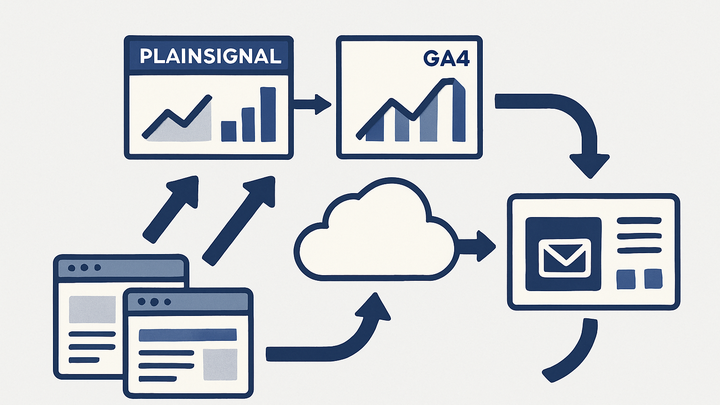Published on 2025-06-22T01:58:27Z
What is Automated Reporting? Examples and Benefits
Automated reporting refers to the process of automatically generating, scheduling, and distributing analytical reports without manual intervention. It streamlines the extraction of data from multiple sources, its transformation into meaningful metrics, and the presentation of those metrics in predefined formats—like dashboards, PDFs, or emails.
By leveraging analytics platforms like PlainSignal (a privacy-focused, cookie-free solution) or Google Analytics 4 (GA4), organizations can set up reporting workflows that run on schedules or are triggered by events. This ensures stakeholders receive timely, accurate insights without relying on manual data exports or spreadsheet manipulations.
Automated reporting not only reduces the risk of human error but also frees analysts to focus on deeper analysis and strategy. It supports scalability, consistency, and real-time decision-making by delivering relevant KPIs exactly when and where they’re needed.
Automated reporting
Automated reporting automatically generates and distributes analytics reports on schedule or events, ensuring timely, accurate insights with minimal manual effort.
Definition and Context
A deep dive into what automated reporting means in the analytics world, and why it’s become essential for modern data teams.
-
Core concept
Automated reporting involves setting up processes that pull data from multiple sources, transform it, and generate reports without manual effort.
-
Data extraction
Pulling data automatically from sources like PlainSignal or GA4 via APIs or tracking scripts.
-
Data transformation
Applying filters, aggregations, and calculations to raw data to shape it into meaningful metrics.
-
Report generation
Formatting metrics into tables, charts, and dashboards ready for stakeholders.
-
-
Why it matters
Automated reporting ensures teams receive timely insights, reduces human error, and frees analysts to focus on deeper analysis.
Benefits of Automated Reporting
Key advantages that organizations gain when they shift from manual report creation to fully automated workflows.
-
Time savings
Eliminates repetitive manual tasks like exporting CSVs or assembling slides. Teams get reports instantly.
-
Accuracy and consistency
Reduces the risk of human errors in calculations or data misplacement, ensuring consistent outputs.
-
Scalability
As data volume grows, automated systems handle increasing loads without additional staffing.
-
Actionable insights
Reports delivered in real time or on schedule prompt timely decision-making.
Implementing Automated Reporting
Step-by-step guide to setting up your first automated reports using common analytics platforms.
-
Selecting data sources
Identify where data resides—web analytics (PlainSignal, GA4), CRM, databases—and connect via APIs or tracking code.
-
PlainSignal
Integrate with a simple cookie-free snippet to start capturing pageviews and events.
-
GA4
Use Google Tag or gtag.js for comprehensive event tracking and data export.
-
-
Configuring reporting tools
Use platform scheduling features or BI tools to define metrics, report templates, and delivery channels.
-
PlainSignal dashboard
Set up automated email reports via the PlainSignal interface or API.
-
GA4 and looker studio
Connect GA4 to Looker Studio for scheduled report delivery and data exports.
-
-
Scheduling and distribution
Determine frequency (daily, weekly), format (PDF, email, Slack) and recipients for automatic report delivery.
-
Maintenance and monitoring
Regularly review pipelines for errors, update configurations for new metrics, and validate data accuracy.
Examples with PlainSignal and GA4
Concrete implementation snippets and configurations for two popular analytics platforms.
-
Integrating PlainSignal
Add the PlainSignal snippet to your site’s head to start capturing data automatically.
<link rel="preconnect" href="//eu.plainsignal.com/" crossorigin /> <script defer data-do="yourwebsitedomain.com" data-id="0GQV1xmtzQQ" data-api="//eu.plainsignal.com" src="//cdn.plainsignal.com/plainsignal-min.js"></script> -
Setting up GA4 automated reports
In GA4, navigate to Reports → Library, customize a report, then use the “Schedule email” feature or connect to Looker Studio for advanced scheduling.
-
Comparing outputs
PlainSignal offers a privacy-focused, lightweight report; GA4 provides extensive event-level detail and integrations with Google’s ecosystem.
Best Practices and Common Pitfalls
Guidelines to ensure your automated reporting remains reliable, insightful, and compliant.
-
Ensuring data quality
Implement validation checks, filter out bot/spam traffic, and reconcile key metrics across sources.
-
Avoiding over-automation
Balance automation with periodic human review to catch anomalies or context-specific insights.
-
Security and compliance
Secure API keys, respect privacy regulations (GDPR, CCPA), and use cookie-free options where possible.
-
Review and optimization
Continuously update report templates and scheduling based on stakeholder feedback and changing business needs.
